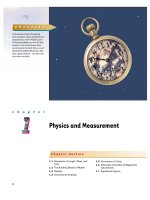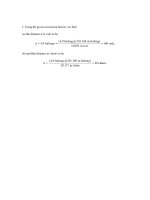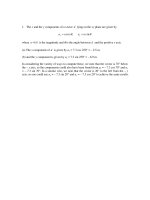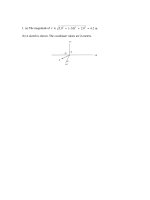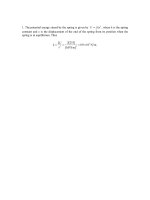- Trang chủ >>
- Khoa Học Tự Nhiên >>
- Vật lý
A students pocket companion fundamentals of physics
Bạn đang xem bản rút gọn của tài liệu. Xem và tải ngay bản đầy đủ của tài liệu tại đây (40.08 MB, 372 trang )
A
Student's
Pocket Companion
FUNDAMENTALS
OF PHYSICS
FIFTH EDITION
J.
Richard Christman
Halli day
NEDS BOOKSTORE
No
Return w/o labe
www.pdfgrip.com
www.pdfgrip.com
A STUDENT'S POCKET COMPANION
J.
Richard Christman
U.S.
Coast
to
Guard Academy
accompany
FUNDAMENTALS OF
PHYSICS
FEFTH EDITION
David Haluday
University of Pittsburgh
Robert Resnick
Rensselaer Polytechnic Institute
Jearl Walker
Cleveland State University
John Wiley
New York
Chichester
&
Sons, Inc.
Brisbane
Toronto
Singapore
www.pdfgrip.com
Copyright
©
1997 by John Wiley
& Sons, Inc.
All rights reserved.
Reproduction or translation of any part of this work
beyond that permitted by Sections 107 and 108 of
the 1976 United States Copyright Act without the
permission of the copyright owner is unlawfiil.
Requests for permission or further information
should be addressed to the Permissions Department,
John Wiley
&
Sons, Inc.
ISBN 0-47 1-09675-X
Printed in the United States of America
1098765432
Printed and bound by Courier Westford
www.pdfgrip.com
PREFACE
A Student's Pocket Companion io Fundamentals of Physics, fifth ediby Halliday, Resnick, and Walker lists the important ideas covered
each section of the text, with a few sentences about each, and gives the
basic equations. It serves three purposes. First, it can be taken to class as
a substitute for the text. You might want to check off the topics covered
wide left
and make short notes to remind yourself of important points.
margin and a notes section at the end of each chapter are provided for
this purpose. Second, it can be used as a handy reference for ideas and
equations while working problem assignments. Third, it can be used to
review text material before an exam or when you need to recall an idea
from a previous chapter.
Readingyl Student's Pocket Companion is NOT a substitute for reading the text. Some derivations and applications are outlined in^ Pocket
Student's Companion but they are necessarily shortened. The text contains much more detail and much fuller explanations. Study the text well,
preferably before class, then use>4 Student's Pocket Companion to remind
yourself of the material you have studied. If it fails to jog your memory,
restudy the appropriate portion of the text.
short vocabulary list is provided at the beginning of each chapter. In order to understand the material of the chapter you should know the meanings of these words and
phrases. Some definitions are given in^ Student's Pocket Companion-, for
other definitions you should refer to the text.
Full understanding of the ideas outlined in^ Student's Pocket Companion will help you greatly in solving problems. However, problem solving techniques are not explicitly covered. For help in solving problems
refer to the Sample Problems of the text, the full size Student's Companion, and the Solutions Manual. Also read the Problem Solving Tactics
tion,
in
A
A
sections of the text.
Preface
iii
www.pdfgrip.com
&
Many good people at John Wiley Sons helped put
together y4 Student's Pocket Companion. Among them, Cliff Mills, Joan
Kalkut, Erica Liu, and Rita Kerrigan were instrumental in the conception, design, and production. Catherine Donovan, in her usual efficient
Acknowledgements
manner, carried out a myriad of essential tasks. Stuart Johnson, the current Physics Editor, has supported the latest edition. Monica Stipanov
and Jennifer Bruer have each contributed in a great many ways. I am
grateful to them all. I am also grateful to Karen Christman, who carefully proofread the manuscript. Very special thanks goes to Mary Ellen
Christman, whose support and encouragement seem to know no bound.
J.
Richard Christman
U.S. Coast
Guard Academy
New London, CT
iv
06320
Preface
www.pdfgrip.com
TABLE OF CONTENTS
Measurement
1
Chapter!
Motion Along a Straight Line
5
Chapters
Vectors
Chapter 4
Motion
Chapter 5
Force and Motion
Chapter
1
13
in T\vo
and Three Dimensions
21
Chapter 6
—
Force and Motion —
Chapter 7
Kinetic Energy and
Chapter 8
Potential
Chapter 9
Systems of Particles
59
Chapter 10
Collisions
67
Chapter 11
Rotation
73
Chapter 12
Rolling, Tbrque,
Chapter 13
Equilibrium and Elasticity
Gravitation
Chapter 15
Fluids
and Angular
43
Momentum
81
89
Ill
Chapter 18
Chapter 19
Tbmperature, Heat,
Chapter 20
The
Chapter 21
Entropy and the Second
Chapter 22
Electric
Chapter 23
Electric Fields
Chapter 24
Gauss*
and the
I
119
II
127
First
Law of Thermodynamics
Kinetic Theory of Gases
Thermodynamics
Table of Contents
49
95
Oscillations
Waves
of
...
103
—
—
Waves
Chapter 17
37
II
Work
Energy and Conservation of Energy
Chapter 14
Chapter 16
29
I
Charge
Law
135
145
Law
153
161
165
171
www.pdfgrip.com
Chapter 25
Electric Potential
179
Chapter 26
Capacitance
187
Chapter 27
Current and Resistance
193
Chapter 28
Circuits
201
Chapter 29
Magnetic Fields
Chapter 30
Magnetic Fields
Chapter 31
Induction and Inductance
Chapter 32
Magnetism of Matter; Maxwell's Equations
Chapter 33
Electromagnetic Oscillations
and Alternating Current
245
Chapter 34
Electromagnetic Waves
255
Chapter 35
Images
265
Chapter 36
Interference
275
Chapter 37
Diffraction
283
Chapter 38
Relativity
291
Chapter 39
Photons and Matter Waves
301
Chapter 40
More About Matter Waves
311
Chapter 41
All
Chapter 42
Conduction of Electricity in Solids
Chapter 43
Nuclear Physics
337
Chapter 44
Energy from the Nucleus
343
Chapter 45
Quarks, Leptons, and the Big Bang
349
vi
207
Due
to Currents
About Atoms
215
221
.
.
.
233
319
329
Table of Contents
www.pdfgrip.com
Chapter
1
MEASUREMENT
Physics is an experimental science and relies strongly on accurate measurements of physical quantities. All measurements are comparisons, either direct or indirect, with standards. This
means
that for every quantity
you must not only have a qualitative understanding of what the quantity
represents but also an understanding of how it is measured. A length
measurement is a familiar example. You should know that the length
of an object represents its extent in space and also that length might be
measured by comparison with a meter stick, say, whose length is accurately known in terms of the SI standard for the meter. Make a point of
understanding both aspects of each new quantity as it is introduced.
Important Concepts
n
n
n
unit
standard
base quantity
(base unit, base standard)
n
International System of Units
1-1
n
D
D
D
D
conversion factor
meter
second
kilogram
atomic mass unit
Measuring Things
n A unit
is
a well-defined quantity with which other quantities
are compared in a measurement.
length is the meter, the unit of time
of mass is the kilogram.
n
Some
Examples: the unit of
is
the second, the unit
units are defined in terms of others.
the unit for speed
is
For example,
the meter per second. Others are base
units and are defined in terms of standards. Ideally, a standard should be accessible and invariable.
n A system of units consists of a unit for each physical quantity, organized so that all can be derived from a small number of independent base units.
Chapter 1:
Measurement
1
www.pdfgrip.com
1-2
The International System of Units
n
This system
is
called the SI system (previously, the metric
system).
n
The three International System base
units used in
mechan-
ics are:
length:
time:
mass:
D
meter (abbreviation: m)
second (abbreviation: s)
kilogram (abbreviation: kg)
SI prefixes are used to represent powers of ten.
lowing are used the most:
Power of Tbn
Svmbol
kilo:
10^
k
mega:
10^
M
centi:
10-2
c
milli:
10-3
m
micro:
10-6
nano:
10-9
pico:
10-12
Prefix
The
fol-
f^
n
P
Memorize them. When evaluating an algebraic expression,
substitute the value using the appropriate
That
is,
for example,
if
a length
is
power of
ten.
given as 25 /im, sub-
25 X 10-6 m. Qj^g catch: the SI unit for mass is
the kilogram Thus, a mass of 25 kg is substituted directly,
stitute
.
while a mass of 25 g
1-3
substituted as 25 x 10" ^ kg.
Changing Units
n
2
is
There are usually several common units for each physical
quantity. For example, length can be measured in meters,
feet, yards, miles, light years, and other units.
Chapter
1:
Measurement
www.pdfgrip.com
n
A quantity given in one unit
is converted to another by mulby a conversion factor. Some conversion factors
are listed in Appendix D of the text.
tiplying
n
Carefully study Section 1-3 to see how a quantity given
one unit is converted to another. Cultivate the good
in
habit of saying the words associated with a conversion. Sup-
pose you want to convert 50 ft to meters. Appendix D tells
that 1ft is equivalent to 0.3048 m. Say "Since 1ft is
equivalent to 0.3048 m, then 50 ft must be equivalent to
(50 ft) X (0.3048 m/ft) = 15 m".
you
1-4
Length
n
n
n
The
SI standard for the meter
light
during a time interval of 1/299, 792, 458s.
the distance traveled by
is
This makes the speed of light exactly 299, 792, 458 m/s.
T^ble 1-3 gives
some
lengths.
Note the wide range of val-
ues.
1-5
Time
n
The
SI standard for the second is the time taken for ex770 vibrations of a certain light emitted by
cesium- 133 atoms.
actly 9, 192, 631,
n
'Rible
1-4
lists
some time
intervals.
Note the wide range of
values.
1-6
Mass
n
The SI standard
for the kilogram
is
the mass of a platinum-
iridium cylinder carefully stored at the International Bureau of Weights and Measures near Paris, France.
n A second mass unit
is the atomic mass unit, abbreviated u
and defined so the mass of a carbon-12 atom is exactly 12 u.
1
n
Chapter 1:
u = 1.6605402 X lO'^^
'Rible
1-5
lists
Measurement
kg.
some masses. Note
the wide range of values.
www.pdfgrip.com
NOTES:
Chapter
1:
Measurement
www.pdfgrip.com
Chapter 2
MOTION ALONG A STRAIGHT LINE
This chapter introduces you to some of the concepts used to describe motion; most important are those of position, velocity, and acceleration. Pay
particular attention to their definitions and to the relationships between
them.
Important Concepts
n (instantaneous) speed
D average acceleration
n (instantaneous) acceleration
n motion with constant
n particle
n coordinate axis
n origin
n coordinate
D displacement
n average velocity
n average speed
n (instantaneous) velocity
2-1
acceleration
n
n
free-fall acceleration
free-fall
motion
Motion
n
In this section of the
text, objects
are treated as particles.
A particle has no extent in space and has no internal parts
that can
move
relative to
each other.
It
may have
other
properties, such as mass.
An extended object can be treated as a particle if all points
it move along parallel lines. It cannot rotate and it cannot deform. If an extended object can be treated as a par-
in
we may pick one point on the object and follow its
motion. The position of a crate, for example, means the
position of the point on the crate we have chosen to follow,
perhaps one of its corners.
ticle,
Chapter
2:
Motion Along a Straight Line
www.pdfgrip.com
2-2
Position and Displacement
n
The motion of a particle in one dimension can be described
by giving its coordinate x as a function of time t. Draw a
coordinate axis along the line of motion of the particle and
select one point on the axis to be the origin. The distance
from the origin to the particle is the magnitude of the coordinate. The coordinate is positive if it is on the side of the
origin designated positive and negative if it is on the side
designated negative.
n
You must
carefully distinguish between an instant of time
and an interval of time. The symbol t represents an instant
and has no extension. Thus, t might be exactly 12 min, 2.43 s
after noon on a certain day. At any other time, no matter
how close, t has a different value. On the other hand, an
interval extends from some initial time to some final time:
two instants of time are required to describe it. Note that a
value of the time may be positive or negative, depending on
whether the instant is after or before the instant designated
as
n
^
=
0.
Similarly, a value of the coordinate x specifies a point
the X
axis. It
on
has no extension in space.
n A displacement
is
a difference in two coordinates. If a par-
goes from xi to X2 during some interval of time, its
displacement during that interval is Ax = X2 - xi. Notice
that the initial coordinate is subtracted from the final coordinate. This definition is valid no matter what the signs of
ticle
XI and X2'
n
particles that start at xj and end at X2 have the same
displacement no matter what their motions. The magnitude of the displacement during a time interval may be different from the distance traveled during the interval. The
difference is pronounced if, for example, the particle moves
TWo
back and forth several times
Chapter
2:
in the interval.
Motion Along a Straight Line
www.pdfgrip.com
2-3
Average Velocity and Average Speed
n
If a particle goes from xj at time ^i to X2 at time ^2» its
average velocity v in the interval from
_ _ X2 — XI _ Ax
" A/"'
ti -ti
where
n
If
Ax =
X2
-
xi and
At =
you are given the function
t2
-t-
I.
and are asked for the avfrom ti to /2» first evaluate
x(^)
erage velocity in some interval
the function for < = into the defining equation.
n
On a graph of x vs.
from
^1 to ^2 is
t the average velocity over the interval
given by the slope of the line from ^i, xj to
^2' On the graph below ti = 2.0s and ti = 8.0 s. The
average velocity in this interval is the slope of the dotted
hy
line.
n
A downward sloping line (from left to right) has a negative
slope and indicates a negative average velocity.
An upward
sloping line has a positive slope and indicates a positive velocity.
n
Carefully distinguish between average velocity and average
speed.
The average speed over a time interval At
by
s
=
d
A^
Chapter
2:
Motion Abng a Straight Line
is
defined
www.pdfgrip.com
where d
is distance traveled in the interval. This may be
quite different from the displacement if the particle moves
back and forth during the
2-4
interval.
Instantaneous Velocity and Speed
n
The instantaneous
velocity is the velocity at an instant of
time (not over an interval). It is defined as the limiting
value of the average velocity in an interval as the interval
shrinks to zero. The term "velocity" means instantaneous
velocity. The adjective "instantaneous" is implied.
n A positive velocity means that the particle
positive X direction.
that the particle
n
is
is
traveling in the
Similarly, a negative velocity
means
traveling in the negative x direction.
the function x(t) is known, the velocity at any time ti is
found by finding the derivative ofx(t) with respect to t and
evaluating the result for / = ti. The velocity at any time t
is given by
If
On a graph of x vs. t, the velocity at any time ti is the slope
of the straight line that is tangent to the curve at the point
corresponding to ^ = ^i. On the graph below the slope of
the slanted dotted line gives the velocity at time = 7.0 s.
2
4
6
8
10
t(s)
Chapter
2:
Motion Along a Straight Line
www.pdfgrip.com
n
The instantaneous speed
(or just plain speed) of a particle
the magnitude of its velocity. If the velocity is -5.0 m/s,
for example, then the speed is +5.0 m/s.
is
2-5
Acceleration
D
If
the velocity of a particle changes from vi at time ^i to V2
its average acceleration a over the
at a later time /2> then
from
interval
ti
tot 2
is
given by
t2-ti
where
At;
=
t;2
-
vi
" a7'
and At = ii-^i- Notice that the veof the interval is subtracted from the
locity at the beginning
velocity at the end. Also notice that instantaneous velocities
appear
n
in the definition.
function x(/) is given, first differentiate it with respect
to / to find the velocity as a function of time, then evaluate
the result for times ti and ^2 to find values for v^ and t;2Substitute the values into the defining equation for the avIf the
erage acceleration.
n
On a
terval
graph of v vs t, the average acceleration over the infrom tiioti'^ the slope of the line from t\yVi ioti,
V2.
n
The instantaneous
acceleration gives the acceleration of
the particle at an instant of time, rather than over an inter-
val. It is
the limiting value of the average acceleration as the
interval
becomes
acceleration"
n
zero. "Acceleration"
mean
the
same
is known, the instantaneous accelerafound by differentiating it with respect to i. If the
function x{t) is known, the instantaneous acceleration is
found by differentiating it twice with respect to i:
If
the function v{i)
tion
is
dv
Chapter
2:
and "instantaneous
thing.
Motion Along a Straight Line
d^x
9
www.pdfgrip.com
n
On a graph of v vs. t, the instantaneous acceleration at any
time ti is the slope of the straight line that is tangent to the
curve at/ = ti.
n
Note that a
positive acceleration does not necessarily
the particle speed
mean
increasing and a negative acceleration
does not necessarily mean the particle speed is decreasing.
The speed
the
same
increases
sign
At the
ation
if
the velocity and acceleration have
and decreases
matter what the
n
is
instant a particle
not necessarily
is
if
they have opposite signs, no
signs.
is
0.
momentarily at rest its accelerIf, at an instant, the velocity is
zero but the acceleration is not, then in the next instant the
is not zero and the particle is moving.
velocity
2-6
Constant Acceleration:
n
A Special
Case
moving along the x axis with constant accelcoordinate and velocity are given as functions
If a particle is
eration
a, its
of time
t
=
x(t)
by
XQ
+
VQt
+
and
jat^
v(t)
=
vq
-\-
at
is its coordinate at / =
and vq is its velocity at
Notice that the second equation is the derivative of
where xq
t
=
0.
the first
n
Eq. 2-16 of the text
V
It
n
is
also extremely useful.
=
Vq
-{-
2a{x
—
Xq)
It is
.
gives the velocity as a function of the coordinate.
Problems involving motion with constant acceleration are
worked by solving these equations for the unknowns. Usually two events are described in the problem statement. Select the time to be zero at one of the events, xq is the coordinate of the particle and vq is its velocity then. The other
event occurs at some time t. x is the coordinate and v is the
velocity then. The other quantity that enters is the accela. Of the six quantities that occur in the equations,
four are usually given or implied and two are unknown.
eration
10
Chapter
2:
Motion Along a Straight Line
www.pdfgrip.com
2-7
Another Look
Constant Acceleration
n
Integration can be used to derive the equations for motion
with constant acceleration. If a is the acceleration, then the
velocity is given by f (^) = J adt + C = at + Cy where C is a
constant of integration. Its physical meaning is the velocity
in the equation above.
at / = 0. lb see this, just set / =
Thus, C = VQ and v(t) = vq -k- at.
n
The coordinate
C
= / v(t) d< +
= f(vQ +
+ C\ where C' is a constant of
integration. It is the coordinate when ^ = 0. Thus, C' = xq
and x(t) = Xq + 1^0^ + jat^.
at)(lt
2-8
at
+
C
=
given by x(t)
is
VQt
+
^at^
Free-Fail Acceleration
n
Every object near the surface of the Earth, if acted on only
by the gravitational force of the Earth, has the same acceleration, called the free-fall acceleration and denoted by g.
It is downward, toward the Earth. The value of g is independent of the mass or shape of the object. It varies slightly
from place
n
to place
on the Earth.
In the absence of air resistance, a ball (or any other object)
thrown upward has the same acceleration
ing
its
upward
the very top of
n
flight,
its
during
its
at all times: dur-
downward
fall,
and even
at
trajectory.
The constant acceleration equations are
to deal with free-fall motion.
somewhat
drawn with
revised
A vertical y axis
is
the upward direction being positive and the equations are
written
2/(0
and
=
yo
+
^0^
-
v'^
'^(O
J9^^y
= v^-
2g{y
-
= ^0-
9iy
y^).
They can be obtained from the equations given previously
for
motion along an x
axis
by substituting y for x and
-g
for a.
Chapter
2:
Motion Along a Straight Line
11
www.pdfgrip.com
n
Problems dealing with free fall are solved in exactly the
as other problems dealing with constant accel-
same way
eration.
2-9
The
Particles of Physics
n
Quantum physics deals with phenomena at the atomic and
subatomic levels. Matter ultimately is not continuous but is
made up of quanta of matter, called particles. Other quantities, such as energy, are also "lumpy" (quantized) at the
atomic level and below.
n
An atom consists of a central, highly compact nucleus, surrounded by one or more electrons and
is
held together by
electrical forces.
n
An atomic nucleus is composed
ticles,
called neutrons,
called protons.
and
The protons
of electrically neutral par-
electrically
charged particles,
repel each other electrically,
neutrons and protons in a nucleus attract each other
The neutrons provide the glue
that holds a nucleus together.
but
all
via a strong nuclear force.
n
Protons, neutrons, and many other particles (but not electrons) are not fundamental but rather are composed of particles known as quarks.
n
Quarks and leptons (of which the electron is one) seem
be the fundamental building blocks of nature.
to
NOTES:
12
Chapter
2:
Motion Along a Straight Line
www.pdfgrip.com
Chapter 3
VECTORS
You
ter,
will deal with
you
will learn
mathematically.
dividends later.
A
vector quantities throughout the course. In this chapabout their properties and how they are manipulated
solid understanding of this material will pay handsome
Important Concepts
n vector
n scalar
n component of a vector
n unit vector
n vector addition
n negative of a vector
5-1
n vector subtraction
D multiplication of a vector
by a scalar
D scalar product of two vectors
D vector product of two vectors
Vectors and Scalars
n A vector quantity has a direction as well as a magnitude and
obeys the rules of vector addition (discussed later in this
chapter). In contrast, a scalar quantity has only a magnitude and obeys the rules of ordinary arithmetic. Displacement, velocity, acceleration, and force are vector quantities; mass, speed, charge, and temperature are scalar quantities.
n A vector
is
represented graphically by an arrow in the di-
rection of the vector, with length proportional to the
mag-
nitude of the vector (according to some scale). As an algebraic symbol, a vector is written in boldface (a, for example) or with an arrow over the symbol (a). The magnitude
of a is written a, in italics (or not bold and without an arrow) or as |a| (or \a\). Be sure you follow this convention.
Chapter
3:
Vectors
13
www.pdfgrip.com
helps you distinguish vectors from scalars and components of vectors. It helps you communicate properly with
It
your instructors and exam graders.
you mean
a
+
6,
for example.
Do not write a + 6 when
They have
entirely different
meanings!
n
Displacement vectors are used
this chapter.
as
A displacement vector
examples of vectors in
is a vector from the po-
sition of a particle at the beginning of a time interval to
position at the end of the interval.
vector
tells
Note
its
that a displacement
us nothing about the path of the object, only the
relationship between the initial and final positions.
you need an example
When
to illustrate addition or subtraction
of vectors, think of displacement vectors.
3-2
Adding Vectors: Graphical Method
n
If
di
is
and di
.4
to point
the displacement vector from point
B
to point C,
then the
from
n
sum
(written d^
-I-
d2)
is
the displacement vector
A to C:
To add two vectors, place the tail of the second vector at
the head of the first, then draw the vector from the tail of
the first to the head of the second. The order in which you
draw the vectors is not important: a-)-b = b + a. Itis
important that the tail of one be at the head of the other
and that the resultant vector be from the "free" tail to the
"free" head, as in the diagram above.
Except
magnitude of the reof the magnitudes of the vec-
in special circumstances, the
sultant vector
14
B
the displacement vector from point
is
is
not the
sum
Chapter
3:
Vectors
www.pdfgrip.com
sum and the direction of the resultant vecnot in the direction of any of the vectors entering the
tors entering the
tor
is
sum.
n
Remember you can reposition a vector as long as you do not
change its magnitude and direction. Thus, if two vectors
you wish to add graphically do not happen to be placed with
the tail of one at the head of the other, simply move one
into the proper position.
n
The
idea of the negative of a vector is used to define vecThe negative of a vector is a vector that is
tor subtraction.
parallel to the original vector but in the opposite direction:
D
Vector subtraction
is
defined by a
-
b
=
a
+
(-b). That
is,
you add a and -b.
n
Notice that vector subtraction is defined so that if a + b = 0,
then a = -b and if c = a + b, then a = c - b. Just subtract
b from both sides of each equation. Vector subtraction is
clearly useful for solving vector equations.
3-3
Components
lb find the x component of a vector, draw lines from the
head and tail to the x axis, both perpendicular to the axis.
The X component of the vector is the projection of the vector on the axis and is indicated by the separation of the
points where the lines meet the axis. Similarly, to find the y
component draw lines from the head and tail to the y axis.
The diagram below shows the components of a vector.
Vectors and Their
n
y
a
Chapter
3:
Vectors
15
www.pdfgrip.com
n
The components of a vector are not vectors themselves but
they can be either positive or negative. The vector in the
diagram above has positive x and y components. The vector in the diagram below has a positive x component and a
negative y component.
n
Given the magnitude a of a vector and the angle 6 it makes
axis, you can find the components using
with the X
ax
= acos^
and
= asm
For these expressions to be valid, 6 must be measured counterclockwise from the positive x direction:
and 90°, both the x and y components are
between 90° and 180°, the x component is
negative and the y component is positive; if ^ is between
180° and 270°, both the x and y components are negative;
if 9 is between 270° and 360°, the x component is positive
and the y component is negative.
If 9 is
between
positive; if ^
D
You must
is
be able to find the magnitude and orientawhen you are given its components. Suppose a vector a lies in the xy plane and its components a^
also
tion of a vector
16
Chapter 3:
Vectors
www.pdfgrip.com
and Qy are
given. In terms of the
tude of a
given by
is
a
=
+a^
yja 2
and the angle a makes with the
by
tan^
=
components, the magni
positive x direction
is
given
^.
Clx
The magnitude
always positive. There are two possible
is
solutions to the equation for 9, the one given by your calculator and that angle plus 180°. You must look at the ori-
entation of the vector to see which
makes
physical sense.
Oy/ox = 0.50, then 6 = 26.6° or 206.6°.
In the first case, both components are positive, while in the
second, both are negative.
For example,
3-4
if
Unit Vectors
n
The unit vectors i, j, and k are used when a vector is written
in
1
n
terms of its components. These vectors have magnitude
and are
Ox i
Oy j
is
and
z directions respectively.
a vector parallel to the x axis with x
component
a^,
a vector parallel to the y axis with y component ay,
a^ k is a vector parallel to the z axis with z component
The vector a
is
a
where the
n
t/,
is
and
Gz.
in the positive x,
given by
= Oxi +
fly j
+
flz
k
rules of vector addition apply.
The symbols
t,
j,
and k are used
to
hand write the unit vec-
tors.
n
Chapter
3:
Units are associated with the components Ox, Oy, and a^
of a vector but not with the unit vectors i, j, and k. Thus,
the same unit vectors can be used to write any vector, no
matter what its units.
Vectors
17

